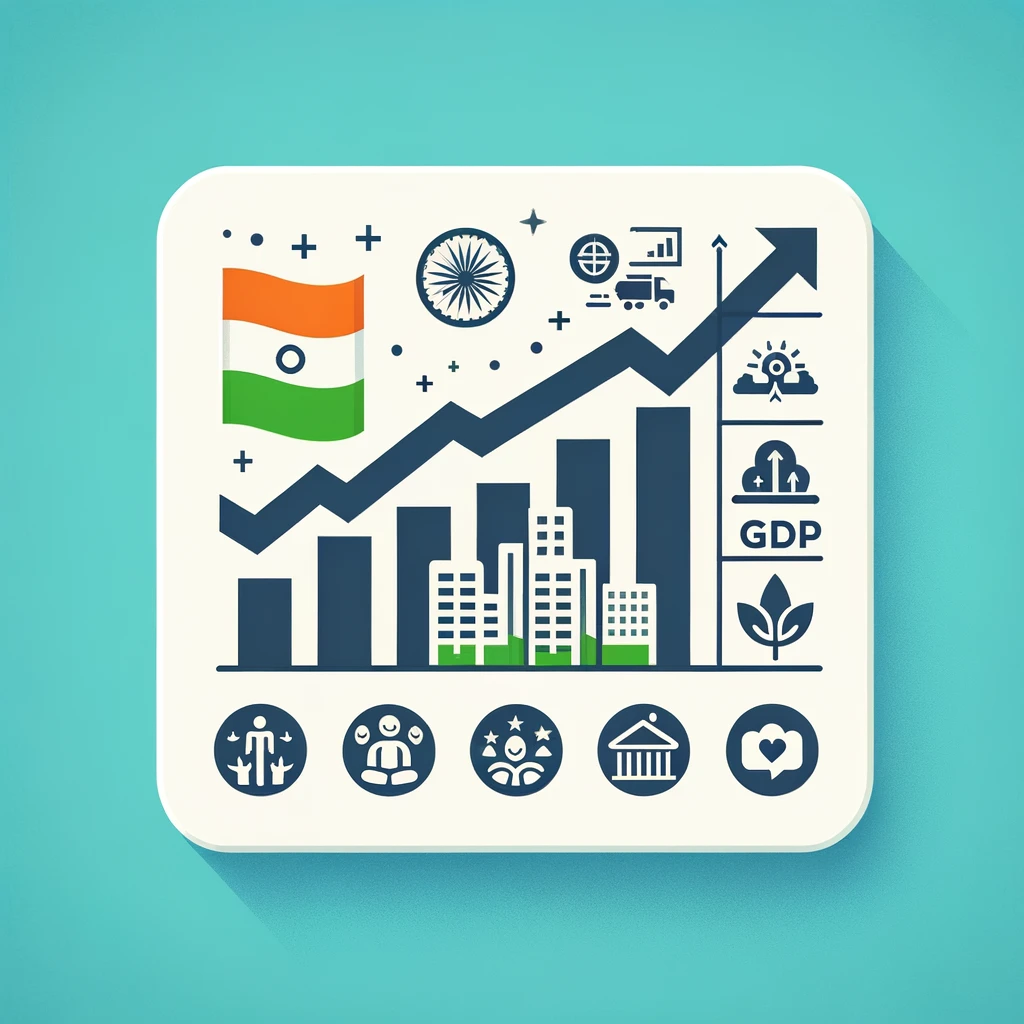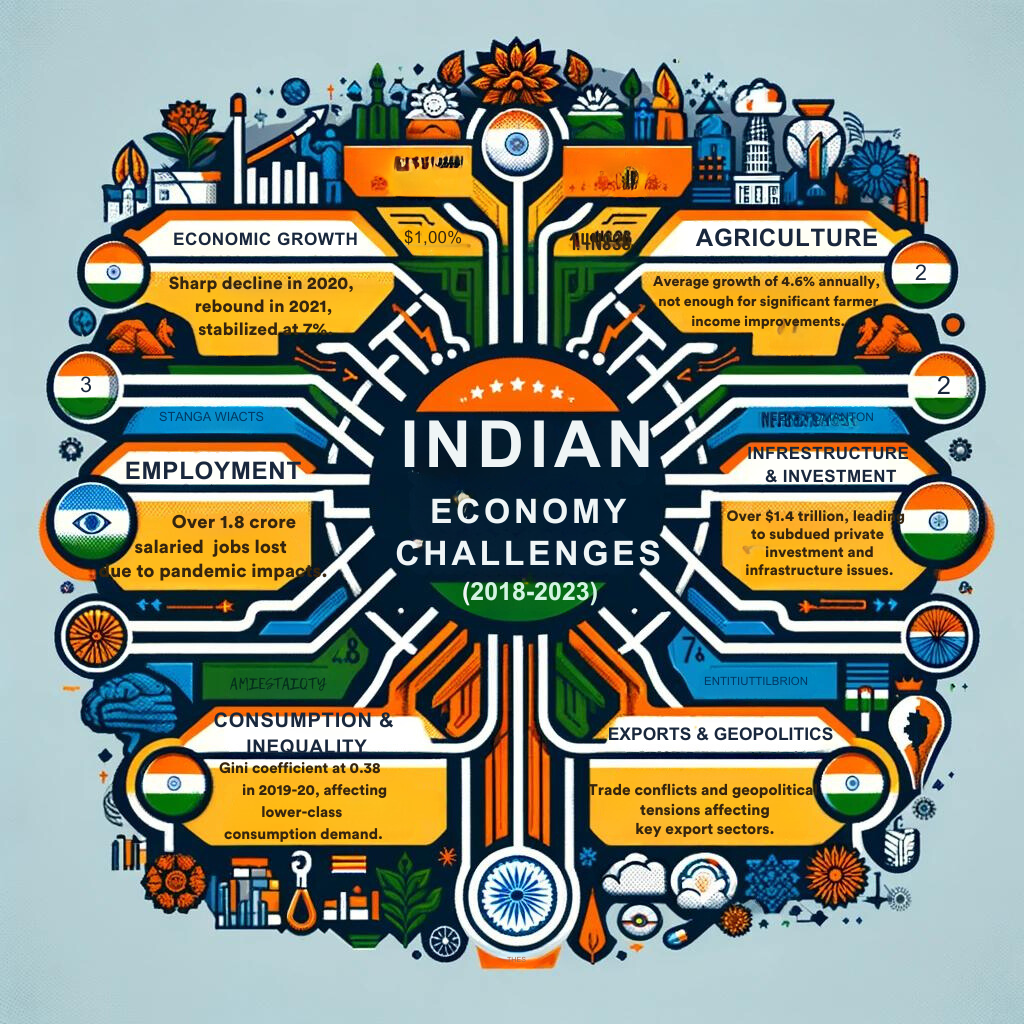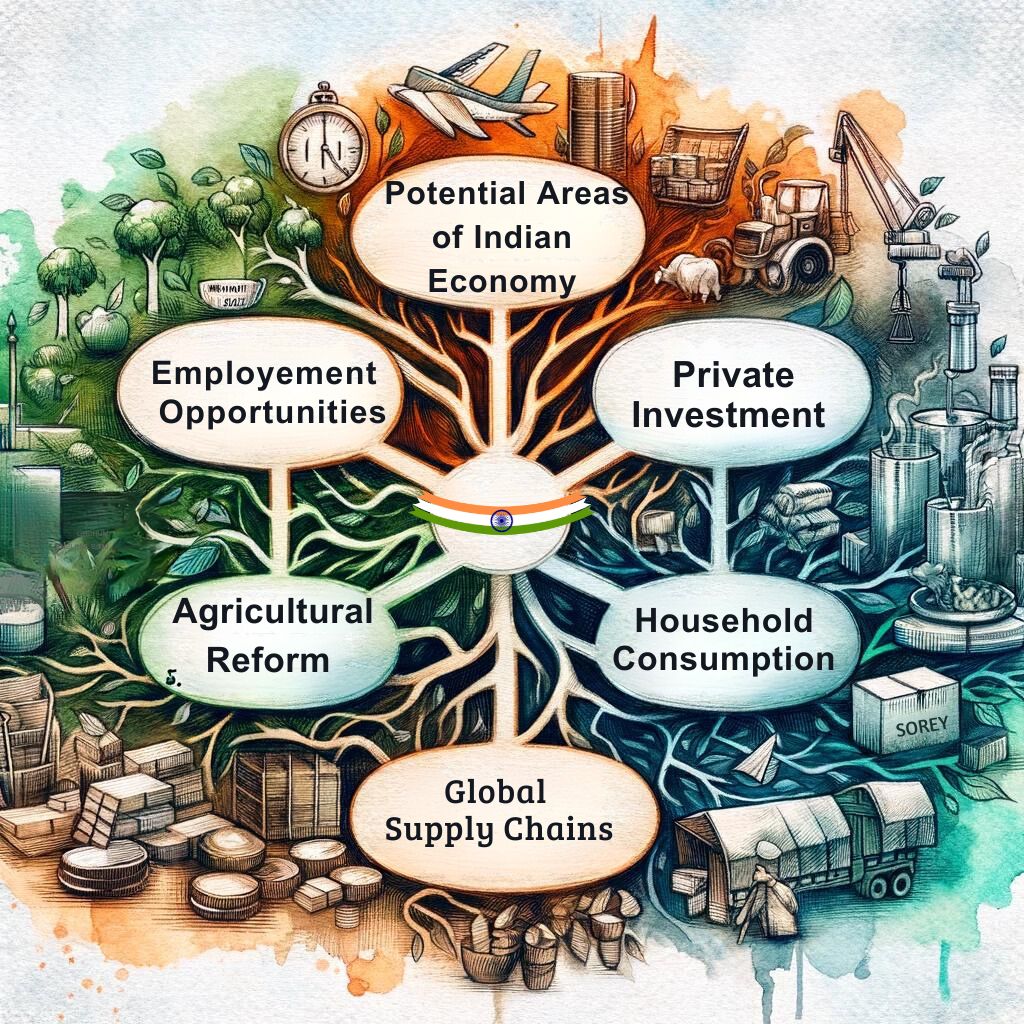Introduction
Significant highs and lows have marked India’s economic journey over the last decade. The country experienced robust GDP growth until 2018–19, but the subsequent years saw a slowdown due to the COVID-19 pandemic. This editorial discusses the main areas that the upcoming government needs to focus on to sustain and enhance Indian economic growth. Understanding these areas is crucial for UPSC aspirants, as they provide insights into the country’s economic policies and challenges.
Origin of the Article
This editorial is based on “Five things the next government needs to focus on,” which was published in The Indian Express on May 16, 2024. The article examines Indian economic performance and key areas for future focus.
Relevancy for UPSC Students
The topic is highly relevant for UPSC aspirants as it covers critical aspects of India’s economy, including GDP growth, unemployment, agricultural reforms, and infrastructure development. Understanding these issues aligns with the UPSC syllabus, particularly in General Studies Paper 3, and enhances knowledge of economic policies and their impacts.

Why in News
This topic is crucial for the UPSC Civil Services exam as it offers an in-depth analysis of India’s economic trajectory, challenges, and opportunities. Understanding the economic performance over the past decade, its resilience, and the sectors that need immediate attention can help aspirants critically evaluate government policies. This aligns with previous UPSC questions on economic growth, unemployment, and sectoral reforms, making it essential for both prelims and mains preparation.
Current State of the Indian Economy in Different Sectors
The Indian economy exhibits diverse performance across sectors, with technology and services showing robust growth, while manufacturing and agriculture face ongoing challenges. This variation underscores the need for targeted policy interventions to harness strengths and address weaknesses in specific areas.
Robust Growth
India’s economy has demonstrated robust and resilient growth over the past decade, catapulting from the 10th to the 5th largest globally. The International Monetary Fund (IMF) forecasts India’s GDP growth to be 6.8% for the fiscal year 2024/25 and 6.5% for 2025/26, highlighting India’s position as the fastest-growing economy among G20 nations.
Current Account Deficit
As per the Economic Survey 2024, India’s current account deficit has significantly reduced to 1% of GDP in the first half of FY24. This improvement is attributed to resilient service exports and decreased oil import costs, marking a positive trend in the nation’s economic health.
Foreign Investment
Robust foreign institutional investor (FII) inflows have bolstered forex reserves to approximately $643 billion. FII inflows stood at $41 billion in 2023–24, contrasting with net outflows of $5.5 billion in the preceding year, thus strengthening India’s financial stability.
Infrastructural Development
The nation’s infrastructural development has been remarkable, with 74 airports constructed in the last 9 years. The capital expenditure (Capex)-to GDP ratio surged to 3.3% for FY24 and is projected to reach 3.4% in the upcoming financial year, showcasing the government’s commitment to improving infrastructure.
Manufacturing Sector
Manufacturing sector capacity utilization is reaching 74%, nearing the long-term average. There are signs of a potential acceleration in the private capital expenditure cycle in the upcoming quarters, indicating a promising future for the sector.
Inflation
Consumer Price Index (CPI) inflation has dipped below the Reserve Bank of India’s upper target band of 6%. Core inflation has remained below 4% in April 2024, primarily due to disinflation in the services sector, reflecting effective monetary policies.
Decline in Urban Unemployment
The economy expanded by an estimated 7.3% in 2023–24, building upon the growth rates of 9.1% in FY22 and 7.2% in FY23. Concurrently, the urban unemployment rate saw a decline to 6.6%, indicating strong economic growth supporting employment.
Rural Demand
Positive trends are evident in the Fast Moving Consumer Goods (FMCG) volume growth in rural areas, which surged from 2.2% to 6.2% in the latter half of 2023, as per a Nielsen report. This indicates rising demand and economic improvement in rural regions.
Various Challenges Faced by the Indian Economy in the Past Five Years
Over the past five years, the Indian economy has navigated a complex landscape of challenges, from fluctuating global market conditions to internal structural issues. These obstacles have tested the economy’s resilience and set the stage for discussions on strategic responses.
Slowdown in Economic Growth
The COVID-19 pandemic led to a substantial economic decline in India in 2020, causing a negative growth rate. However, the economy witnessed a strong rebound in 2021, recording a growth rate of approximately 9%, subsequently stabilizing around 7%.
Unemployment and Underemployment
The COVID-19 pandemic exacerbated job losses as businesses shut down or reduced operations. According to the Centre for Monitoring Indian Economy (CMIE), over 1.8 crore salaried jobs were lost between April and July 2020, significantly impacting the unemployment rate.
Challenges in Agriculture and Allied Sectors
The agricultural sector has lagged despite GDP growth. India’s agriculture and allied sectors have experienced an average annual growth rate of 4.6% over the past six years. Thus, being insufficient for substantial improvements in farmer incomes, with the sector’s GDP contribution dipping to 15% in FY23.
Slowing Household Consumption and Income Inequality
High levels of income inequality lead to deterioration in consumption demand, especially for the lower income classes. India’s Gini coefficient was 0.38 in 2019–20, indicating significant income disparities, which negatively impact investment demand and growth.
Infrastructure Deficit and Private Investment
India’s infrastructure deficit is estimated at over $1.4 trillion, affecting key areas like transportation, energy, and healthcare. Private investment remains subdued, with Gross Fixed Capital Formation (GFCF) by private corporations declining by -14.5% in FY 2020–21, highlighting the need for robust infrastructure development.
Export Challenges Amid Geopolitical Tensions
Geopolitical tensions, such as border disputes and trade conflicts, have disrupted global trade patterns. Industries like textile and pharmaceutical exports have faced challenges, with India’s growth failing to keep pace with global market expansion.

Multiple Initiatives Taken for the Growth of Different Sectors
In response to the challenges faced, the Indian government has launched multiple initiatives aimed at stimulating growth across various sectors.
New Economic Policy, 2020
The NEP 2020 encompasses a substantial stimulus package amounting to Rs 20 lakh crore, aimed at bolstering different sectors and segments of the economy. This policy includes reforms in agriculture, labor, education, health, defense, and taxation, fostering self-reliance in the economic landscape.
Strategic Disinvestment
India has embarked on the privatization of public-sector enterprises (PSEs) to enhance efficiency and mobilize resources for development. Since 1991, India has privatized more than 60 PSEs, raising over Rs 3 lakh crore, reflecting a significant shift towards a market-driven economy.
Comprehensive Labor Codes
Four codes have been introduced to streamline and consolidate central labor laws into categories like wages, industrial relations, social security, and occupational safety. These codes aim to offer employers flexibility in workforce management and expand social security coverage for informal workers.
Production-Linked Incentive (PLI)
The PLI scheme aims to scale up domestic manufacturing capability, encouraging production in key sectors to boost economic growth and create employment opportunities.
PM Gati Shakti- National Master Plan
This multimodal connectivity infrastructure project is designed to improve transportation and logistics. Thereby, enhancing efficiency and reducing costs across various sectors.
Bharatmala Project
Focused on improving connectivity in North-East India, the Bharatmala Project aims to boost regional development and integrate these areas with the national economy.
Start-up India
This initiative aims to catalyze the startup culture in India, providing support and resources to new ventures and thereby fostering innovation and entrepreneurship.
Make in India 2.0
Aimed at transforming India into a global design and manufacturing hub. This initiative focuses on enhancing the country’s production capabilities and competitiveness in the global market.
Potential Areas of the Indian Economy that Need to be Focused On
While significant strides have been made, there remain critical areas within the Indian economy that require focused attention to unlock their full potential. Following are the key sectors in the Indian Economy that can catalyze substantial growth and development.
Creating Employment Opportunities
Employment generation requires a conducive environment driven by consumption-led growth. Policies aimed at boosting consumption will indirectly contribute to sustainable job creation, primarily driven by the private sector.
Reviving Private Investment
Encouraging private sector participation with incentives like the PLI scheme and investment allowances is crucial. Private companies need conducive conditions to drive growth, making expanding and supporting investment initiatives essential.
Agricultural Reform
Addressing challenges in agriculture through government participation, policy clarity, and standardizing procurement and distribution procedures is essential. Revisiting bans on futures trading can enhance market efficiency and productivity.
Boosting Household Consumption
Stimulating consumption through fiscal measures like revisiting tax rates and rationalizing GST slabs is necessary. Addressing declining household savings through revamped tax structures is imperative to sustain economic growth.
Integration into Global Supply Chains
Enhancing participation in global supply chains through free trade agreements and focusing on merchandise exports is essential. While the IT sector has excelled, emphasis on merchandise exports is necessary for balanced economic growth.

Conclusion
In conclusion, India stands at a pivotal juncture of its economic journey, grappling with both challenges and opportunities. The next government must prioritize employment generation, agricultural reforms, and boosting private investment to ensure sustainable growth. With strategic policies and robust implementation, India can harness its potential to emerge as a resilient and thriving economy. Civil services aspirants should delve deep into these dynamics to contribute effectively to the nation’s progress.



